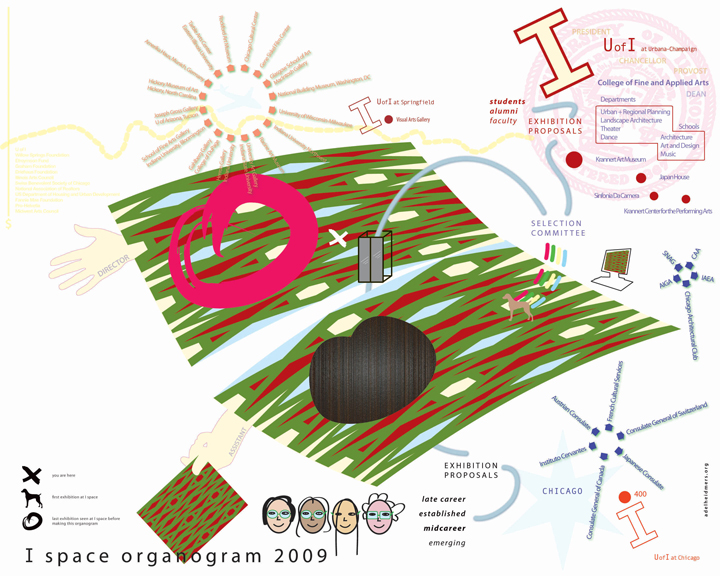
THE ORGANOGRAM
By Mary Antonakos, Director, I space, Chicago Gallery of the College of Fine and Applied Arts, Unversity of Illinois at Urbana-Champaign
In 2007, an exhibition organized by the Chicago Art Critics Association was proposed for I space, Chicago gallery of the University of Illinois at Urbana- Champaign. Each critic in Response: Art and the Art of Criticism was asked to select an artist, and write about the work for the exhibition. The exhibition was nally realized, with 13 critics, 13 artists and a catalogue featuring essays and full color reproductions of the work at I space in April of 2009. Fred Camper, one of the participating critics selected work by Adelheid Mers for the exhibition. Mers proposed an Organogram about I space for the exhibition which would involve research and an in depth interview with me, the director of the gallery, since its inception in 1992. My contribution was to give the artist all of the relevant information dealing with the way the gallery functions within its community over the course of the 16 years the gallery had been in existence. This involved thinking about and researching the museums, galleries and other institutions we have worked with.
Connections to Cultural Embassies from Canada, Japan, Germany, Sweden, Switzerland and Spain were illustrated. Small details involving our programming and the way the gallery functions were given symbols and icons that were meaningful to those involved. It also detailed the various connections the gallery has with our home campus at Champaign-Urbana and our relationship to the entire University of Illinois as a whole. This information-not always clear to visitors to the gallery-became a graphic example of these connections and relationships in the Organogram. Mers process of visually synthesising the activities and relationships the gallery has participated in was enlightening. Our reach was far more widespread than we were aware. The relationships developed over 16 years were a credit to the faculty, students and sta involved with I space and it was gratifying to see these relationships—so integral to how a university art gallery functionsmapped out and on display.
The work was based on facts, and o ered concrete evidence of the e ect this gallery has had on the lives of artists in our community. At the same time, it o ered an opportunity to participate in the creative process that Mers has been exploring in this new body of work. And in its presentation, the work was informative, amusing and visually intricate; o ering a challenging viewing opportunity for everyone attending the exhibition in the gallery. The process was also somewhat bittersweet as news of funding for I space was becoming more and more dire. Although the Organogram did not deal with any of our financial issues, it did outline for us, as a gallery supported by a research institution, the value of our work in our community. It also inspired me, and several other people who saw the Organogram and the exhibition to continue to work harder to ensure our presence in Chicago.
At the time of the exhibition, our tenure in our current location was to end soon after the end of the exhibition. With help from our landlord and a genuine belief that we can continue to operate the gallery in Chicago, our lease was extended through December of this year. Work continues to ensure the gallery will continue here for another 10 years. It would not be correct to say that the Organogram saved I space, but the process of revisualizing the gallery, of looking back at what has been accomplished did, in a meaningful and unique way, give a perspective on the role of I space in Chicago, and beyond.